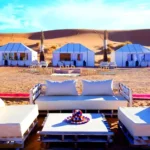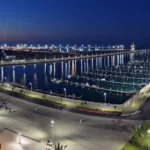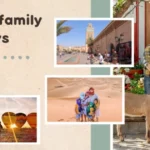Table of Contents
The first time I stepped into Djemaa el-Fna at dusk, the smoke from the food stalls, the sound of the snake charmers, and the energy of the crowd were an assault on the senses in the best way possible. Marrakech isn’t just a city you see; it’s a city you feel. And after most trips organizing exclusive journeys through this magical Red City, we are here to help you navigate it all.
Whether you’re planning your first visit or returning to discover hidden gems, this comprehensive guide will transform your Marrakech experience from ordinary to extraordinary. From the labyrinthine souks to the tranquil gardens, from authentic hammams to desert adventures, I’ve curated the ultimate list of what to do in Marrakech based on years of crafting personalized itineraries for discerning travelers.
Quick Guide: Top 5 Can’t-Miss Things to Do in Marrakech
Before we dive deep, here are the absolute essentials that should anchor any Marrakech itinerary:
• Djemaa el-Fna Square – The beating heart of Marrakech, alive with storytellers, musicians, and food vendors
• The Souks – Navigate the maze of traditional markets for handcrafted treasures and authentic shopping experiences
• Jardin Majorelle – Escape the city’s intensity in this cobalt blue botanical paradise
• Bahia Palace – Marvel at 19th-century Moroccan architecture and intricate tilework
• Ben Youssef Madrasa – Discover the spiritual and architectural heritage of Islamic scholarship
The 27 Best Things to Do in Marrakech
Things to do in Marrakech: Iconic Sights & Landmarks
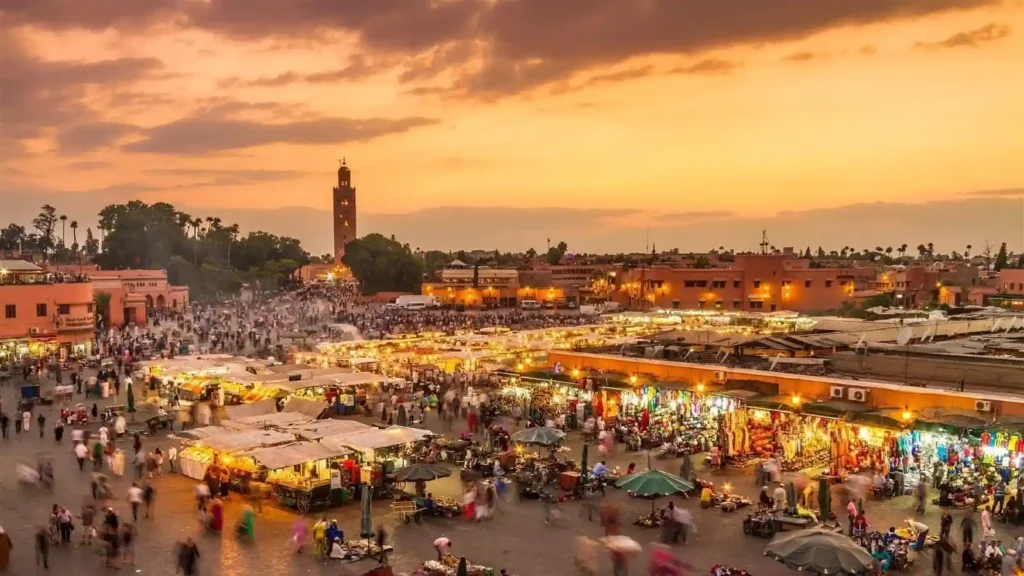
1. Djemaa El fna Square
What It Is: The UNESCO World Heritage main square that has been the cultural heart of Marrakech for over 1,000 years.
Why You Should Go: This isn’t just a tourist attraction; it’s a living theater where Berber storytellers, acrobats, and musicians perform exactly as they have for centuries. As the sun sets, the square transforms into an open-air restaurant with dozens of food stalls creating an intoxicating symphony of aromas and flavors.
Insider Tip: Visit twice – once during the day to see the snake charmers and henna artists, and again after sunset when the food stalls come alive. The best panoramic views are from the rooftop terraces of Café Argana or Restaurant Nomad.
Logistics:
- Location: Djemaa el-Fna, Marrakech 40000
- Cost: Free (food and activities cost extra)
- Hours: 24/7, but most active from 9 AM to midnight
2. Koutoubia Mosque
What It Is: The largest mosque in Marrakech, famous for its 253-foot minaret that dominates the city skyline.
Why You Should Go: This 12th-century architectural masterpiece represents the pinnacle of Almohad design and serves as the spiritual anchor of the city. The minaret’s proportions were so perfect that it inspired the Giralda in Seville and the Hassan Tower in Rabat.
Insider Tip: While non-Muslims cannot enter the mosque, the surrounding gardens offer the best photography opportunities, especially during golden hour when the minaret glows against the Atlas Mountains backdrop.
Logistics:
- Location: Avenue Mohammed V, Marrakech
- Cost: Free (exterior viewing)
- Hours: Always visible; gardens open from sunrise to sunset
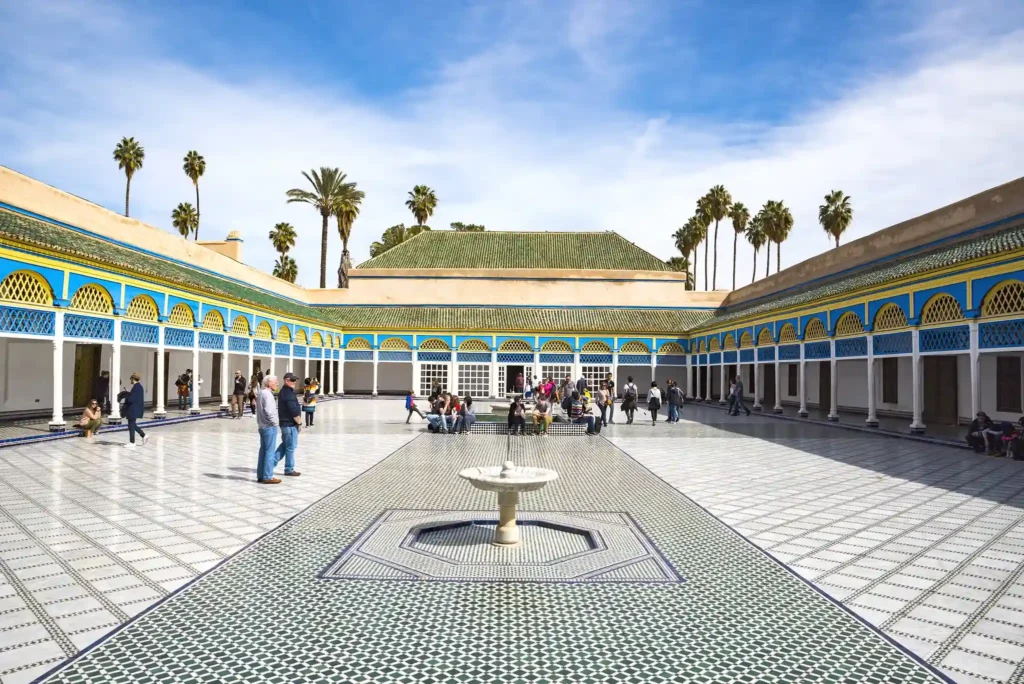
3. Bahia Palace
What It Is: A 19th-century palace complex showcasing the finest Moroccan craftsmanship with intricate mosaics, carved cedar ceilings, and peaceful courtyards.
Why You Should Go: This palace tells the story of Morocco’s royal heritage through its opulent rooms and gardens. Each chamber reveals different aspects of Moroccan architectural evolution, from Moorish influences to French colonial touches.
Insider Tip: Enter through the main gate, but spend most of your time in the private apartments section, where the light filtering through the stained glass creates magical photography opportunities.
Logistics:
- Location: 5 Rue Riad Zitoun el Jdid, Marrakech
- Cost: 70 MAD (~$7 USD)
- Hours: 9 AM – 5 PM daily
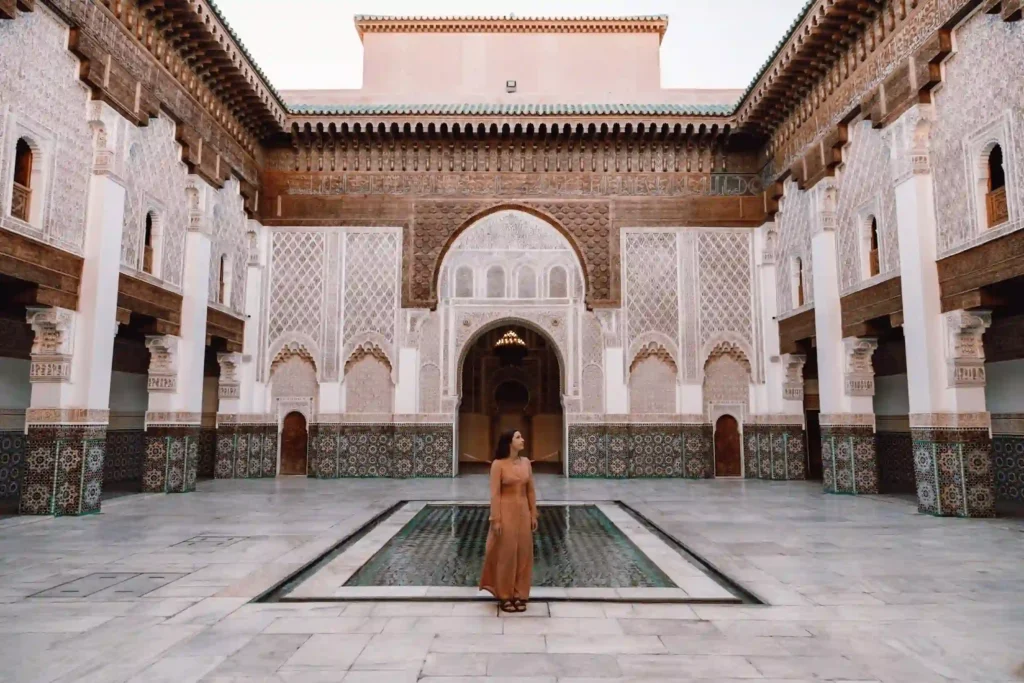
4. Ben Youssef Madrasa
What It Is: A 14th-century Islamic college that once housed 900 students, featuring some of Morocco’s most exquisite architectural details.
Why You Should Go: This former theological college represents the height of Moroccan educational tradition. The geometric patterns, Arabic calligraphy, and play of light through the student chambers create an almost mystical atmosphere.
Insider Tip: Visit in the morning when natural light illuminates the central courtyard’s intricate stucco work. The upper-level student cells offer unique perspective shots of the courtyard below.
Logistics:
- Location: Derb Ibn Souleiman, Marrakech
- Cost: 50 MAD (~$5 USD)
- Hours: 9 AM – 6 PM daily
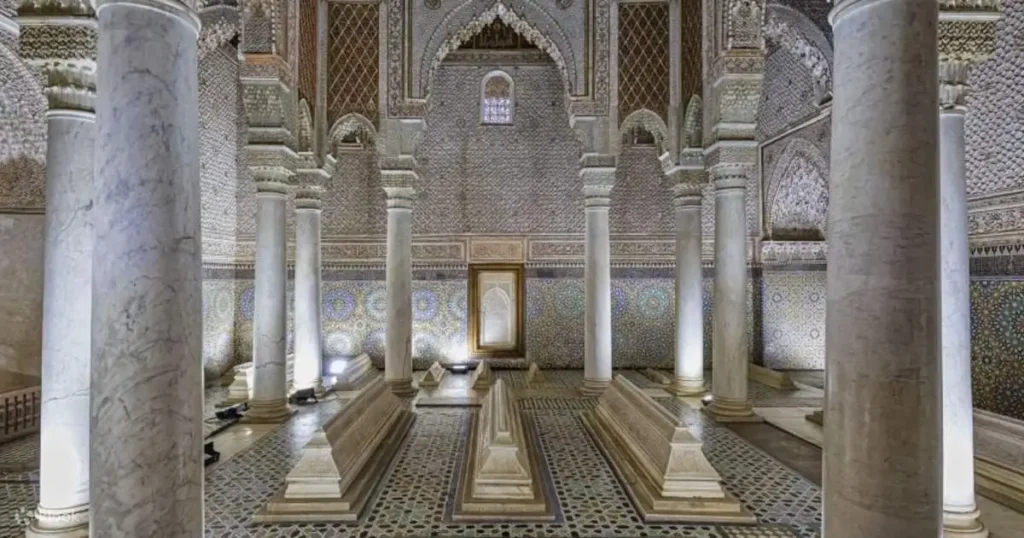
5. Saadian Tombs
What It Is: Royal mausoleums dating to the 16th century, hidden for centuries and rediscovered in 1917.
Why You Should Go: These tombs represent a fascinating chapter in Moroccan history, sealed off by Sultan Moulay Ismail and forgotten until the French colonial period. The marble columns, gold leaf decorations, and Italian Carrara marble showcase the dynasty’s wealth and artistic patronage.
Insider Tip: The Hall of Twelve Columns, where Sultan Ahmed al-Mansur is buried, is the most photographed spot, but the children’s cemetery offers a more intimate and less crowded experience.
Logistics:
- Location: Rue de la Kasbah, Marrakech
- Cost: 70 MAD (~$7 USD)
- Hours: 9 AM – 5 PM daily
Things to do in Marrakech: Cultural Experiences
6. Get Lost in the Souks
What It Is: A vast network of traditional markets covering over 40,000 square meters in the old medina.
Why You Should Go: The souks aren’t just shopping destinations; they’re living museums where traditional crafts continue exactly as they have for centuries. Each section specializes in different trades – from babouche makers to metalworkers to spice merchants.
Insider Tip: Start at the main entrance near Djemaa el-Fna, but don’t be afraid to venture into smaller side alleys where prices are lower and craftsmen work in their traditional workshops. Always negotiate – starting at 30% of the initial price is standard.
Logistics:
- Location: Souk Semmarine, Marrakech Medina
- Cost: Free to browse
- Hours: 9 AM – 8 PM (Friday mornings reduced hours)
7. Take a Traditional Cooking Class
What It Is: Hands-on culinary experiences where you learn to prepare authentic Moroccan dishes like tagines, couscous, and pastries.
Why You Should Go: Moroccan cuisine reflects the country’s rich cultural crossroads, blending Arab, Berber, Mediterranean, and French influences. Learning these techniques connects you with centuries of culinary tradition.
Insider Tip: Choose classes that include a market tour where you’ll learn about local ingredients and spices. The best experiences happen in traditional riads where you cook in authentic clay tagines over charcoal.
Logistics:
- Location: Various locations throughout Marrakech
- Cost: 400-800 MAD (~$40-80 USD)
- Hours: Usually 4-6 hour experiences
8. Experience a Traditional Hammam
What It Is: Traditional Moroccan bathhouses offering steam baths, exfoliation treatments, and massage therapies.
Why You Should Go: The hammam experience represents centuries of Moroccan wellness tradition, combining physical cleansing with spiritual renewal. It’s an essential cultural ritual that locals practice weekly.
Insider Tip: Choose between public hammams (more authentic, less expensive) and private spa hammams (more luxurious, tourist-friendly). For your first experience, Les Bains de Marrakech offers a perfect balance of authenticity and comfort.
Logistics:
- Location: Multiple locations throughout the city
- Cost: 50-500 MAD (~$5-50 USD) depending on type
- Hours: Vary by location, typically 8 AM – 10 PM
9. Attend a Gnawa Music Performance
What It Is: Traditional Moroccan music performances featuring hypnotic rhythms, spiritual chanting, and colorful costumes.
Why You Should Go: Gnawa music represents the spiritual heritage of Morocco’s sub-Saharan communities, combining Islamic mysticism with African rhythms. These performances offer deep cultural insight beyond typical tourist experiences.
Insider Tip: The best authentic performances happen at Dar Essalam or during the annual Gnawa Music Festival (usually in June). Evening performances often include traditional mint tea and pastries.
Logistics:
- Location: Various cultural centers and restaurants
- Cost: 150-300 MAD (~$15-30 USD)
- Hours: Evening performances typically 8 PM – 11 PM
10. Explore the Tanneries
What It Is: Traditional leather-working district where hides are processed using methods unchanged for over 1,000 years.
Why You Should Go: This working neighborhood offers an unfiltered glimpse into one of Morocco’s most important traditional industries. The visual impact of hundreds of dyeing vats in vibrant colors creates an unforgettable sensory experience.
Insider Tip: Accept the mint leaves offered at the entrance – they help mask the strong odors. The best viewing terraces are found in the leather shops surrounding the tanneries, where you can watch the process while shopping for authentic leather goods.
Logistics:
- Location: Hay Essalam, Marrakech
- Cost: Small tip expected for terrace access
- Hours: 8 AM – 6 PM (closed Fridays)
Things to do in Marrakech: Gardens & Relaxation
11. Jardin Majorelle
What It Is: A botanical garden created by French painter Jacques Majorelle, later owned by Yves Saint Laurent, featuring exotic plants and the famous Majorelle blue buildings.
Why You Should Go: This garden represents the perfect fusion of European artistic vision and Moroccan natural beauty. The contrast between the electric blue buildings and the lush green vegetation creates an almost surreal atmosphere.
Insider Tip: Visit early morning (8 AM opening) or late afternoon to avoid crowds and harsh midday light. The Berber Museum inside provides excellent context for understanding Morocco’s indigenous culture.
Logistics:
- Location: Rue Yves Saint Laurent, Marrakech
- Cost: 150 MAD (~$15 USD); Museum additional 100 MAD
- Hours: 8 AM – 6 PM daily
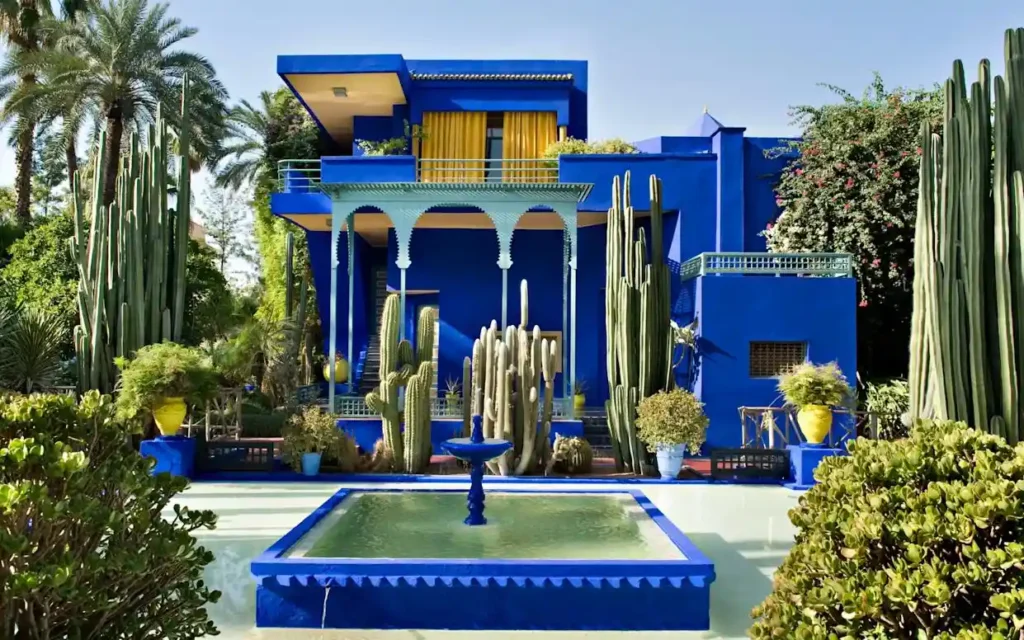
12. Le Jardin Secret
What It Is: A restored 19th-century riad with traditional Islamic and exotic gardens, showcasing 400 years of Moroccan garden design.
Why You Should Go: This hidden gem offers insight into traditional Moroccan architecture and garden design philosophy. The geometric patterns, water features, and carefully planned plant arrangements represent centuries of Islamic garden tradition.
Insider Tip: The rooftop café provides panoramic views of the medina and the Atlas Mountains. Visit during spring (March-May) when the exotic garden blooms with vibrant colors.
Logistics:
- Location: 121 Rue Mouassine, Marrakech
- Cost: 80 MAD (~$8 USD)
- Hours: 9:30 AM – 7:30 PM daily
13. Menara Gardens
What It Is: A 12th-century olive grove with a central pavilion and reflecting pool, representing classical Moroccan landscape design.
Why You Should Go: These gardens offer a peaceful escape from the medina’s intensity while showcasing traditional Moroccan hydraulic engineering. The pavilion’s reflection in the pool, with the Atlas Mountains as backdrop, creates iconic photography opportunities.
Insider Tip: Visit during sunset when the pavilion glows golden against the mountain backdrop. The olive trees are over 700 years old, making this one of the world’s oldest cultivated olive groves.
Logistics:
- Location: Avenue de la Menara, Marrakech
- Cost: 30 MAD (~$3 USD)
- Hours: 8 AM – 6 PM daily
Things to do in Marrakech: Foodie Adventures
14. Food Tour of Djemaa el-Fna
What It Is: Guided culinary journey through the square’s food stalls, sampling traditional dishes and learning about Moroccan cuisine.
Why You Should Go: The evening food stalls represent Morocco’s street food culture at its most authentic. Each stall specializes in different dishes, from grilled meats to fresh orange juice to traditional sweets.
Insider Tip: Stall number 32 serves the best harira soup, while stall 67 offers exceptional grilled sardines. Always eat at stalls with high local customer turnover for the freshest food.
Logistics:
- Location: Djemaa el-Fna Square
- Cost: 200-400 MAD (~$20-40 USD) for full meal
- Hours: 6 PM – midnight
15. Mechoui Alley
What It Is: A narrow alley specializing in mechoui (slow-roasted lamb), where whole lambs are cooked in traditional clay ovens.
Why You Should Go: This represents one of Morocco’s most ancient cooking traditions, where lamb is roasted for hours until it becomes incredibly tender. The communal eating style and family-run establishments offer authentic cultural immersion.
Insider Tip: Chez Lamine (recognizable by its blue door) serves the most tender mechoui. Order by the kilo and share with others – the meat is so rich that 200 grams per person is typically sufficient.
Logistics:
- Location: Riad Zitoun el Kedim, Marrakech
- Cost: 80-120 MAD (~$8-12 USD) per person
- Hours: 11 AM – 4 PM daily
16. Riad Dining Experience
What It Is: Intimate dinner experiences in traditional riads, featuring multi-course Moroccan meals with live entertainment.
Why You Should Go: Riad dining combines authentic Moroccan cuisine with traditional architecture and hospitality. These experiences offer insight into how wealthy Moroccan families historically entertained guests.
Insider Tip: Riad Kniza and Dar Yacout offer the most authentic experiences, while Riad 72 provides a more contemporary interpretation. Book ahead as these intimate venues have limited seating.
Logistics:
- Location: Various riads throughout the medina
- Cost: 400-800 MAD (~$40-80 USD) per person
- Hours: Dinner typically 7:30 PM – 10:30 PM
Things to do in Marrakech: Adventure & Day Trips
17. Atlas Mountains Day Trip
What It Is: Excursions to the High Atlas Mountains, including Berber villages, waterfalls, and traditional mountain culture.
Why You Should Go: The Atlas Mountains provide a dramatic contrast to Marrakech’s desert landscape, offering cooler temperatures, lush valleys, and insight into Morocco’s Berber heritage. The scenery rivals any mountain range in the world.
Insider Tip: The Ourika Valley offers the best combination of accessibility and authentic culture, while Imlil provides access to Mount Toubkal (North Africa’s highest peak). Private guides from local Berber families offer the most authentic experiences.
Logistics:
- Location: 1-2 hours from Marrakech
- Cost: 400-1,200 MAD (~$40-120 USD) per person
- Hours: Full day trips typically 8 AM – 6 PM
18. Agafay Desert Experience
What It Is: Day or overnight trips to the stone desert just outside Marrakech, featuring camel rides, traditional camps, and desert activities.
Why You Should Go: While not the Sahara, the Agafay Desert offers a genuine desert experience within easy reach of Marrakech. The lunar landscape and traditional Berber hospitality create unforgettable memories.
Insider Tip: Overnight experiences include traditional Berber tents, campfire dinners, and stargazing opportunities. The best operators provide authentic nomad experiences rather than tourist-focused “desert hotels.”
Logistics:
- Location: 45 minutes from Marrakech
- Cost: 300-1,500 MAD (~$30-150 USD) per person
- Hours: Day trips or overnight experiences available
19. Essaouira Day Trip
What It Is: Coastal city excursion featuring Portuguese architecture, artisan workshops, and Atlantic Ocean beaches.
Why You Should Go: Essaouira offers the perfect contrast to Marrakech’s inland intensity. The coastal city’s relaxed atmosphere, fresh seafood, and artistic community provide cultural variety within your Morocco itinerary.
Insider Tip: The argan oil cooperatives between Marrakech and Essaouira offer fascinating insights into this uniquely Moroccan industry. Tree-climbing goats are a popular photo opportunity, but choose cooperatives that treat animals ethically.
Logistics:
- Location: 2.5 hours from Marrakech
- Cost: 400-800 MAD (~$40-80 USD) per person
- Hours: Full day trips typically 8 AM – 7 PM
Things to do in Marrakech: Unique Experiences
20. Hot Air Balloon Ride
What It Is: Sunrise balloon flights over the Atlas Mountains and traditional Berber villages surrounding Marrakech.
Why You Should Go: Few experiences match the magic of floating silently over Morocco’s diverse landscapes as the sun rises. The bird’s-eye perspective reveals the country’s geographical and cultural complexity.
Insider Tip: Book with Ciel d’Afrique or Atlas Ballooning for the most professional operations. Flights include a traditional Berber breakfast and a champagne celebration upon landing.
Logistics:
- Location: Various launch sites around Marrakech
- Cost: 2,200-2,800 MAD (~$220-280 USD) per person
- Hours: Early morning flights, typically 5 AM pickup
21. Quad Biking in the Palmeraie
What It Is: Off-road adventures through Marrakech’s palm grove, featuring traditional irrigation systems and rural landscapes.
Why You Should Go: The Palmeraie offers adventure activities within minutes of the city center. Quad biking provides an adrenaline-filled way to explore Morocco’s traditional agricultural systems.
Insider Tip: Choose operators that include visits to traditional Berber houses where you can learn about palm cultivation and irrigation systems. Always wear protective gear and follow safety guidelines.
Logistics:
- Location: Palmeraie, Marrakech
- Cost: 300-600 MAD (~$30-60 USD) per person
- Hours: Morning and afternoon sessions available
22. Traditional Pottery Workshop
What It Is: Hands-on experiences learning traditional Moroccan pottery techniques from master craftsmen.
Why You Should Go: Pottery represents one of Morocco’s most ancient crafts, with techniques passed down through generations. These workshops offer insight into traditional artistic methods and cultural heritage.
Insider Tip: The pottery quarter (Quartier des Potiers) offers the most authentic experiences. Choose workshops that include kiln firing so you can take home finished pieces.
Logistics:
- Location: Pottery Quarter, Sidi Ghanem
- Cost: 200-400 MAD (~$20-40 USD) per person
- Hours: Various times available, typically 3-4 hours
Things to do in Marrakech: Shopping & Markets
23. Souk el Had (Weekend Market)
What It Is: Massive weekend market featuring everything from livestock to household goods, frequented primarily by locals.
Why You Should Go: This authentic market offers insight into everyday Moroccan life away from tourist-focused souks. The variety of goods and local atmosphere provide genuine cultural immersion.
Insider Tip: Visit Saturday mornings for the best selection and most active atmosphere. Bring cash in small denominations and be prepared for intensive bargaining.
Logistics:
- Location: Souk el Had, Marrakech
- Cost: Free entry
- Hours: Saturday and Sunday, 8 AM – 2 PM
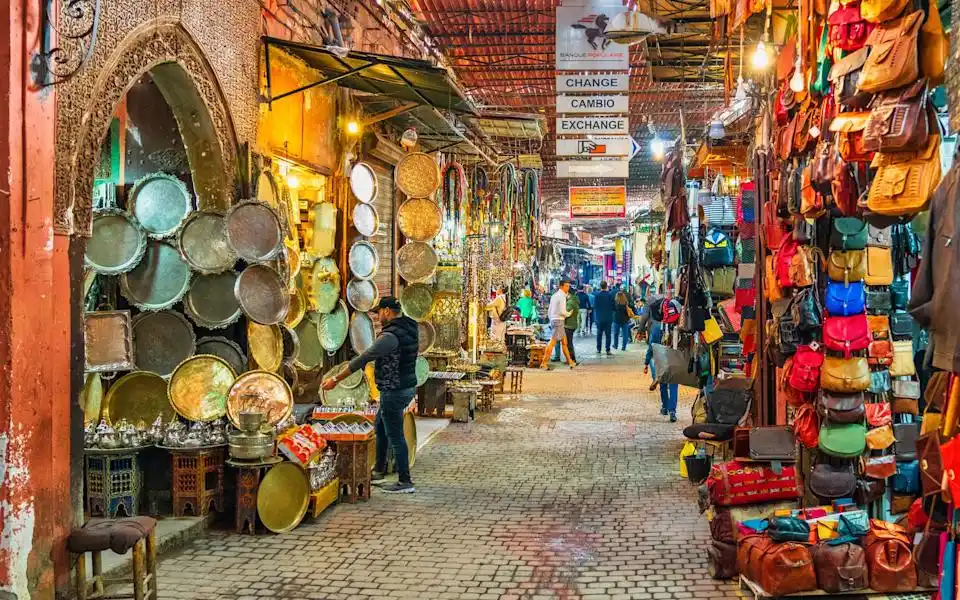
24. Ensemble Artisanal
What It Is: Government-run cooperative featuring fixed-price traditional crafts from certified artisans.
Why You Should Go: This cooperative offers high-quality traditional crafts at fair prices without bargaining pressure. It’s perfect for understanding quality and pricing before venturing into the souks.
Insider Tip: Use this as your first stop to learn about traditional crafts and pricing. The quality standards are high, making it ideal for purchasing gifts or high-value items.
Logistics:
- Location: Avenue Mohammed V, Marrakech
- Cost: Fixed prices
- Hours: 9 AM – 7 PM daily
25. Carpet Weaving Demonstrations
What It Is: Traditional workshops where you can observe master weavers creating authentic Moroccan carpets and learn about different regional styles.
Why You Should Go: Moroccan carpets represent centuries of Berber artistic tradition, with each region having distinct patterns and techniques. These demonstrations provide insight into this complex art form.
Insider Tip: Learn the difference between Berber, Arabic, and mixed-style carpets. Authentic pieces take months to complete and command premium prices. Many workshops offer shipping services for international buyers.
Logistics:
- Location: Various locations in the medina
- Cost: Free demonstrations
- Hours: 9 AM – 6 PM daily
Things to do in Marrakech: Spiritual & Historical Sites
26. Almoravid Koubba
What It Is: The only surviving Almoravid architecture in Marrakech, dating to the 12th century.
Why You Should Go: This small but historically significant building represents the architectural foundations of Marrakech. The geometric patterns and construction techniques influenced all subsequent Moroccan architecture.
Insider Tip: Visit in conjunction with the nearby Ben Youssef Madrasa for a complete understanding of Marrakech’s architectural evolution. The contrast between periods is fascinating.
Logistics:
- Location: Place Ben Youssef, Marrakech
- Cost: 20 MAD (~$2 USD)
- Hours: 9 AM – 6 PM daily
27. Mellah (Jewish Quarter)
What It Is: The historic Jewish quarter features synagogues, traditional architecture, and the Jewish cemetery.
Why You Should Go: The Mellah represents Morocco’s diverse cultural heritage and the long history of Jewish-Muslim coexistence. The architecture and urban planning differ significantly from the traditional medina.
Insider Tip: Visit the Lazama Synagogue and the Jewish cemetery for the most historically significant sites. Local guides can provide context about the community’s history and current status.
Logistics:
- Location: Mellah, Marrakech
- Cost: Small donations appreciated
- Hours: 9 AM – 5 PM (check religious holiday schedules)
Sample Marrakech Itineraries
3-Day Marrakech Itinerary
Day 1: Medina Immersion
- Morning: Djemaa el-Fna and Koutoubia Mosque
- Afternoon: Souk’s exploration and traditional lunch
- Evening: Hammam experience and dinner in the medina
Day 2: Palaces and Gardens
- Morning: Bahia Palace and Saadian Tombs
- Afternoon: Jardin Majorelle and Yves Saint Laurent Museum
- Evening: Rooftop dinner with Medina views
Day 3: Culture and Relaxation
- Morning: Ben Youssef Madrasa and Le Jardin Secret
- Afternoon: Cooking class or pottery workshop
- Evening: Gnawa music performance and farewell dinner
5-Day Marrakech Itinerary
Days 1-3: Follow the 3-day itinerary above
Day 4: Atlas Mountains Adventure
- Full day trip to Ourika Valley or Imlil
- Berber village visits and traditional mountain lunch
- Evening: Rest and traditional massage
Day 5: Desert Experience
- Day trip to Agafay Desert
- Camel riding and traditional desert lunch
- Evening: Sunset in the desert and return to Marrakech
7-Day Marrakech Itinerary
Days 1-5: Follow the 5-day itinerary above
Day 6: Coastal Escape
- Day trip to Essaouira
- Explore the medina, port, and beaches
- Fresh seafood lunch and artisan workshops
Day 7: Final Explorations
- Morning: Hot air balloon ride
- Afternoon: Final shopping and spa treatment
- Evening: Farewell dinner at a luxury riad
Where to Stay in Marrakech
Medina (Old City)
The medina offers the most authentic Marrakech experience, with traditional riads, easy access to major attractions, and immersive cultural atmosphere. However, it can be noisy and navigation can be challenging.
Luxury Option: La Mamounia – Iconic palace hotel with legendary service and prime location Mid-Range Option: Riad Yasmine – Beautifully restored traditional riad with rooftop terrace Budget Option: Riad Marrakech by Hivernage – Authentic atmosphere with modern comforts
Gueliz (New City)
The new city provides modern amenities, easier navigation, and international dining options, but with less authentic Moroccan atmosphere.
Luxury Option: Hotel & Spa Le Doge – Contemporary luxury with traditional touches Mid-Range Option: Ibis Marrakech Centre Gare – Modern comfort with good transportation links. Budget Option: Hotel Toulousain – Clean, comfortable accommodation with French influence
Hivernage
This upscale neighborhood offers luxury hotels, modern shopping, and easy access to both the medina and the airport.
Luxury Option: Four Seasons Resort Marrakech – Exceptional service with Atlas Mountain views. Mid-Range Option: Hotel Marrakech Le Tichka – Boutique hotel with traditional design
Getting Around Marrakech
Petit Taxis
Small red taxis are the most convenient way to travel between neighborhoods. Always insist on using the meter or agree on a price before starting your journey. Typical fares range from 15-40 MAD within the city.
Walking
The medina is best explored on foot, though the labyrinthine streets can be confusing. Download offline maps and always carry your riad’s business card. Comfortable walking shoes are essential.
Grand Taxis
Shared taxis for longer distances or day trips. These cream-colored vehicles typically serve set routes and can be more economical for group travel.
Private Transportation
For day trips and airport transfers, private vehicles offer comfort and convenience. Many riads can arrange reliable drivers for full-day excursions.
Insider Tip: Learn basic French or Arabic phrases for directions. “Shukran” (thank you) and “Wakha” (okay) will be appreciated by locals.
What to Wear & Cultural Etiquette
Dress Code
Morocco is a Muslim country, and modest dress is appreciated, especially when visiting religious sites.
For Women:
- Cover shoulders and knees
- Avoid tight-fitting clothing
- Bring a scarf for mosque visits
- Comfortable walking shoes essential
For Men:
- Long pants preferred
- Shirts with sleeves for religious sites
- Avoid shorts in traditional neighborhoods
- Comfortable, closed-toe shoes recommended
Cultural Etiquette
- Remove shoes when entering homes or some shops
- Use your right hand for eating and greeting
- Ask permission before photographing people
- Respect prayer times and religious customs
- Bargaining is expected in souks but not in fixed-price shops
Photography Guidelines
- Always ask permission before photographing people
- Avoid photographing inside mosques
- Street photography is generally acceptable
- Be respectful in traditional neighborhoods
Is Marrakech Safe? My Honest Advice
After organizing hundreds of trips to Marrakech, I can confidently say that the city is generally safe for tourists who take reasonable precautions. Like any major tourist destination, awareness and common sense are your best protection.
Common Safety Concerns
Pickpocketing: Occurs primarily in crowded areas like Djemaa el-Fna and busy souks. Keep valuables secure and avoid displaying expensive items.
Scams: Common scams include fake guides, overcharging, and aggressive sales tactics. Politely but firmly decline unwanted services.
Traffic: Marrakech traffic can be chaotic. Stay alert when crossing streets and be cautious around motorbikes and scooters.
Safety Tips
- Use reputable accommodation and transportation services
- Keep copies of important documents separate from originals
- Inform someone of your daily plans
- Trust your instincts and remove yourself from uncomfortable situations
- Use hotel safes for valuables
For Solo Travelers
Marrakech is generally safe for solo travelers, including women. However, solo female travelers should dress modestly and be prepared for attention. Staying in well-reviewed riads and using recommended guides enhances safety and cultural understanding.
Emergency Contacts
- Police: 19
- Tourist Police: 0524-38-46-01
- Medical Emergency: 15
Things to do in Marrakech FAQ
How many days do you need in Marrakech?
A minimum of 3-4 days allows you to see the major attractions and get a taste of the culture. However, 5-7 days provides a more relaxed pace with time for day trips, deeper cultural experiences, and proper rest between activities. Many travelers find a week to be the perfect balance.
What is the best month to visit Marrakech?
The best months are March-May and October-November when temperatures are comfortable (70-80°F) and rainfall is minimal. December-February can be cool but pleasant for sightseeing, while June-September is very hot but offers lower hotel rates and fewer crowds.
Is Marrakech expensive?
Marrakech can accommodate any budget level. Budget travelers can experience the city for $30-50 per day, while luxury travelers might spend $300-500+ daily. Mid-range travelers typically spend $100-200 per day including accommodation, meals, and activities.
What language is spoken in Marrakech?
Arabic and Berber are the official languages, but French is widely spoken due to colonial history. English is increasingly common in tourist areas, hotels, and restaurants. Learning basic French phrases will enhance your experience significantly.
Can you drink alcohol in Marrakech?
Yes, alcohol is available in licensed restaurants, bars, and hotels, though it’s not sold in traditional medina establishments. Major hotels have bars, and wine is available with meals in tourist restaurants. Respect local customs and avoid public intoxication.
Final Thoughts: Your Marrakech Adventure Awaits
Marrakech isn’t just a destination—it’s a transformation. From the moment you hear the call to prayer echoing across the red walls to your last sunset over the Atlas Mountains, this city will challenge your senses and expand your understanding of culture, hospitality, and beauty.
The things to do in Marrakech extend far beyond any single list. Every corner turned reveals new discoveries, every conversation with locals provides fresh insights, and every meal offers flavors you’ve never experienced. Whether you’re exploring ancient palaces, haggling in the souks, or sharing mint tea with Berber families in the Atlas Mountains, you’re participating in traditions that have continued for centuries.
Remember that the best experiences often come from being open to the unexpected. That wrong turn in the Medina might lead to the most beautiful courtyard you’ve ever seen. That invitation to share tea with a shopkeeper might become your most treasured memory. That moment of silence in the desert might provide the clarity you’ve been seeking.
What to do in Marrakech ultimately depends on what calls to your spirit. Are you seeking adventure in the desert dunes? Cultural immersion in ancient madrasas? Culinary discoveries in family-run restaurants? Artistic inspiration in centuries-old crafts? Or perhaps the simple pleasure of watching the world go by from a rooftop café as the sun sets behind the Atlas Mountains?
Whatever draws you to this magnificent city, approach it with curiosity, respect, and an open heart. The rewards will extend far beyond your itinerary and stay with you long after you’ve returned home.
The magic of Marrakech lies not just in its monuments and markets but in its ability to remind us that the world is vast, cultures are rich, and human connections transcend language and borders. In a city where ancient traditions meet modern aspirations, where the Sahara Desert meets the Atlas Mountains, and where every sunset paints the sky in impossible colors, you’ll discover that the greatest adventure is often the journey within yourself.
Ready to start planning your Marrakech adventure? Do you have any questions about planning your trip to this incredible city? Ask me anything in the comments below – I read and reply to every one! Whether you’re wondering about the best time to visit, need help choosing between different experiences, or want insider tips for your specific interests, I’m here to help make your Marrakech journey unforgettable.
Experience Morocco with Desert Merzouga Tours
After years of exploring Morocco and witnessing countless travelers fall in love with this extraordinary country, I can confidently recommend Desert Merzouga Tours for those seeking authentic, personalized Moroccan experiences that go far beyond typical tourist offerings.
What sets Desert Merzouga Tours apart:
Customized Exclusive Journeys: Every itinerary is tailored to your interests, whether you’re passionate about cultural immersion, adventure activities, culinary experiences, or historical exploration. No two trips are identical because no two travelers are the same.
Expert Local Guides: Professional guides with deep knowledge of Moroccan culture, history, and hidden gems ensure you experience the real Morocco, not just the tourist version. They’re storytellers, cultural ambassadors, and skilled navigators who transform sightseeing into meaningful encounters.
Comprehensive Morocco Coverage: While Marrakech is magnificent, Morocco’s diversity extends from the imperial cities of Fes and Casablanca to the breathtaking Sahara Desert and majestic Atlas Mountains. Desert Merzouga Tours showcases this incredible range, including iconic landmarks like the Hassan II Mosque and the ancient kasbah of Aït Benhaddou.
Authentic Cultural Experiences: From hands-on cooking classes and traditional hammam treatments to overnight desert camping and Atlas Mountain trekking, every activity is designed to connect you authentically with local culture and communities.
Premium Comfort: Experience Morocco in style with carefully selected accommodations, from luxury riads in the Medina to exclusive desert camps under the stars, all while enjoying premium transportation and seamless logistics.
Sustainable Tourism: Committed to responsible travel that benefits local communities and preserves Morocco’s natural and cultural heritage for future generations.
Whether you’re planning a romantic getaway, a family adventure, or a solo cultural exploration, Desert Merzouga Tours creates what to do in Marrakech experiences that become lifelong memories. Their expertise in crafting personalized itineraries ensures every moment of your Moroccan journey is meaningful, comfortable, and unforgettable.
Ready to transform your Marrakech dreams into reality? Contact Desert Merzouga Tours to begin planning your personalized Moroccan adventure today.



